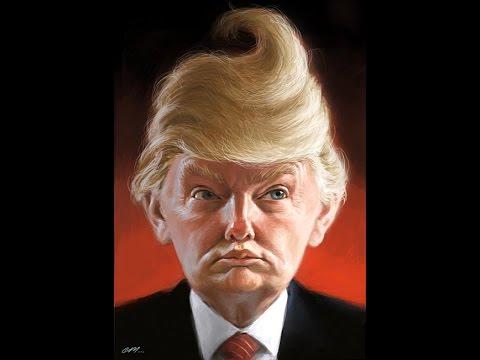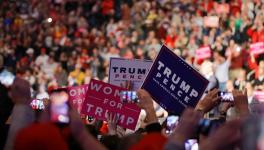Pulling out of the Iran Deal: Or Humpty Drumpf-ty’s Impending Fall

Last week, Trump decertified the Iran nuclear deal – known as the Joint Comprehensive Plan of Action (JCPOA) – while, at the same time, not pulling out of it. He has asked the US Congress to put in additional sanctions on Iran, so that Iran “behaves” the way US wants it. This is after months of threatening to quit the deal – in his view the worst deal ever – and blaming Iran for not observing the “spirit” of the agreement, whatever that means.
JCPOA has the five permanent members of the Security Council, namely the US, Russia, China, UK, France, apart from Iran (P5+1), as parties to the agreement. The 159 page JCPOA document has a detailed a roadmap of actions that Iran has to undertake. All of these have been fulfilled by Iran, and meticulously verified by the International Atomic Energy Association (IAEA) that has been tasked with overseeing the implementation of JCPOA. IAEA has certified that Iran is in full compliance with JCPOA provisions. Key US officials such as the Secretary of State Rex Tillerson, the National Security Adviser H.R. McMaster, and Secretary of Defence Jim Mattis, have all stated that Iran is in full compliance with JCPOA, and that it is in the interest of the US to stay with the Iran deal.
While Trump’s decertifying may not immediately kill the nuclear deal, it does two things. It creates an environment of uncertainty, in which the deal slowly collapses. The US Congress has been itching to impose more sanctions on Iran. Any such sanction would be seen by Iran as a betrayal, forcing it to pull out. The second consequence is that in the future, the US will not be trusted on any such agreement. For North Korea, the lesson of Trump’s decertification would be simple: the only protection against the US lies not in diplomacy, but in nuclear and missile deterrence. An agreement with the US, even if it is backed the UN Security Council as JCPOA was, is simply not worth the paper it is written on.
What did the Iran deal negotiated by the US under Obama achieve? Iran reduced the number of centrifuges from 19,000 to about 6,000, its inventory of Low Enriched Uranium by a whopping 98% – from 10,000 kg to only 300 kg – and stopped Arak and Fordow facilities from all nuclear weapon activities.
The gain for Iran from JCPOA was its regaining its frozen assets over $100 billion. In any case, this money was Iran’s, which was illegally seized or frozen by the US.
Before the deal, the US and Iran were on a course for war, and only the nuclear deal pulled the two countries back from the brink. Iran had accumulated enough fissile material for nuclear weapons. The deal essentially pulled Iran back from such a nuclear break out. For Iran therefore, the US reneging on the deal would be seen as complete bad faith. The two countries would again be locked onto a collision course, this time with very little possibility of a diplomatic compromise.
With Trump decertifying the Iran deal, the issue gets kicked back to the US Congress, which can then reimpose on Iran the sanctions that were suspended by the deal. This would effectively blow it up. While decertification does not automatically terminate the deal, it certainly constitutes a continuing threat to its existence.
Will the US Congress move to end the deal? Or will it let it retain the deal, with a sword of Damocles hanging over it? Here, Israel’s malign influence on the US Congress could be the key. Netanyahu had more influence on the US Congress than even President Obama. The Republicans, and even a significant part of the Democrats in the Congress, are in the pocket of AIPAC, Israel’s lobbying arm in the US. Israel is also backed by a number of very wealthy right-wing backers of Trump, including Sheldon Adelson, the owner of a number of Las Vegas casinos. Adelson has even suggested that the U.S. should strike Iran with nuclear weapons.
All these forces want the US to take out Iran, leaving Israel as the only military power in the region. The US invaded Iraq, and effectively destroyed the country. In Syria, it has funnelled money and arms to a number of extremist groups. It has aligned with al Nusra and ISIS, the two off-spring of al Qaeda, supposedly its mortal enemy in its “global war on terror”. Now the pressure is on taking out Iran, which has not only withstood the US, but has been able to extend its influence, first in Iraq, and now in Syria. Hezbollah has been a long term ally of Iran. Iran, Iraq, Syria and Hezbollah in Lebanon, with the backing of Russia, are formidable foes of Israel in the region. This is why Israel needs the US to take out Iran, the way it took out Iraq.
What then are the reasons Trump has given for decertifying the deal or, as he put it, Iran not observing the “spirit” of the deal?
Well, the spirit of an agreement can mean anything. Trump, like Humpty Dumpty in Alice Through the Looking Glass, believes words can mean what he chooses them to mean. In this case, it is, supposedly, the Iranian involvement in the “terrorist” attack on the US Marine Base in Beirut in 1983, its collaboration with al Qaeda after its World Trade Tower attacks, and its continued testing of ballistic missiles. This apart from “destabilising” the region and opposing US policies in Yemen and Syria. All of which simply means Iran not listening to the US and obeying its diktat!
The US knows that the US marines in Beirut were not neutral in the Lebanese conflict; through mission creep, from ostensibly peacekeepers, they had become allies with Israeli forces and Israeli supported militias in Lebanon. Israel’s invasion and occupation of Lebanon, its massacres in the Palestinian camps of Sabra and Shatila, may be forgotten by the US, but not by the rest of the world. Robert Parry, in Consortium News (September 3, 2015) calls it right: the US marine barracks were a military target, and it certainly was not a terrorist act. And Iran had little to do with it.
Trump’s charge that Iran cooperated with al Qaeda post the 2003 Trade Tower bombings, sounds demented to the rest of the world. Al Qaeda and ISIS are rabid Sunni sectarian forces, owing their allegiance to an extreme version of Wahhabi doctrine that Saudi Arabia also follows. They not only have nothing in common with Shiite Iran, but also consider Shias to be apostates and therefore not fit to live. This is the conflict in Syria. Al Qaeda, ISIS, along with Saudi Arabia, the Gulf states, supported by the US, have all been on the same side, and against the secular government of Bashar al Assad.
While the US has claimed that Iran supports “terrorism” in the region, and is destabilising other governments, it has supported various terrorist organisations in Iran such as Jundalla, Mujahadeen e Khalq (MEK), and has even carried out assassinations of Iranian nuclear scientists on Iranian soil.
The last issue, Iran’s ballistic missile tests: the missiles have a range of a measly 2,000 kms and pose no danger to the US. Saudi and UAE neighbours have a much bigger arsenal of missiles and offensive aircraft than Iran, and spend thirteen times as much as Iran on their military budgets. The JCPOA does not apply to ballistic missiles, and Iran is well within its rights to test such weapons. Yes, they do bring Israel within their range, and that is the cause of Trump’s anger.
The reality is that the US is a weakening global hegemon. It is not able to decide what it should do. Try for an accommodation with regional powers such as Iran and North Korea that it can no longer control? Or re-assert its global dominance which is slowly and surely eroding? How does it play its cards in what the US Army War College calls “A Post Primacy World”? The problem with a Humpty Dumpty view of the world is what happens when Humpty Dumpty falls. Or shall we say when Trumpty Drumpf-ty falls?
Disclaimer: The views expressed here are the author's personal views, and do not necessarily represent the views of Newsclick
Get the latest reports & analysis with people's perspective on Protests, movements & deep analytical videos, discussions of the current affairs in your Telegram app. Subscribe to NewsClick's Telegram channel & get Real-Time updates on stories, as they get published on our website.























